NOVA SCOTIA
Population

Population
Popular destinations CANADA
| Alberta | British columbia | Manitoba |
| New brunswick | Newfoundland and labrador | Northwest territories |
| Nova scotia | Nunavut | Ontario |
| Prince edward island | Quebec | Saskatchwan |
| Yukon |
Population
Nova Scotia has a population of over 1 million (2024), which is just over 20 per square kilometre. Below are the figures for all of Canada.
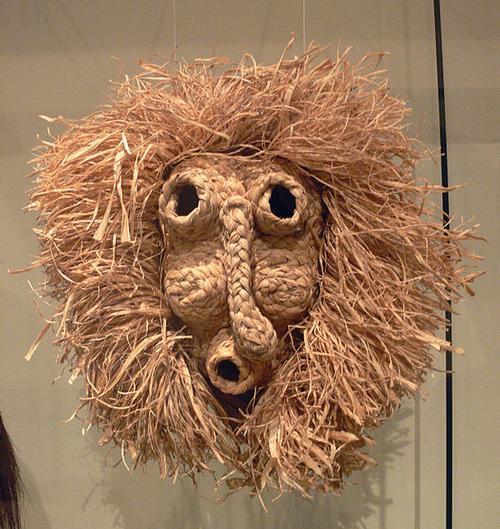
The original inhabitants of Canada are the Indians and the Inuit (Eskimos), who together make up over 4% of the population.
The Indians in Canada can be roughly divided into two groups: the farmers and the hunters. The first group, of which the Iroquois were the largest tribe, mainly lived in what is now Southern Ontario and along the St. Lawrence River. They lived in villages and mainly lived from agriculture. These farmers were the first to come into contact with Europeans and a degree of integration took place over time.
The many tribes that roamed the vast prairies lived on the hunt. They were hunters and collectors, real nomads, who followed the source of their existence: the bison herds. The bison gave the Indians everything they needed: his meat was their food and his skin was used for clothing and for tents (wigwams or teepees) in which they lived.
Currently, approximately 300,000 people are registered as Indian. They are divided into about 600 tribes, the so-called "First Nations", and live in about 2300 reserves.
The distribution of the Indian population differs enormously per province. Most of the Indians live in the provinces of Ontario, Manitoba, Saskatchewan, Alberta, British Columbia and the Yukon Territory. A small number, mainly in the north, still lead a nomadic life as a hunter. The major Indian tribes are: Algonquins from Ontario, Abénaquis and Iroquois from Québec, Micmacs from New Brunswick, Kananaskis from Alberta and Coquitlam and Matsqui from British Columbia.
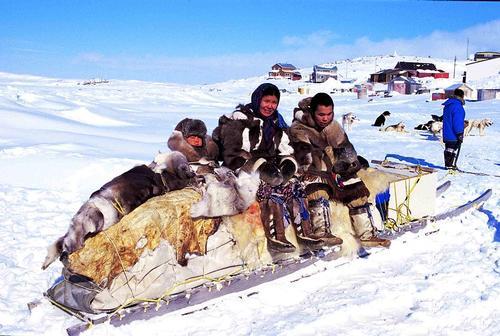
The first group of Mongolian inhabitants of the north crossed the Bering Strait from Asia in a relatively warm period. Also called the pre-Dorset, these nomads spread north across the arctic archipelago and east toward Greenland. They hunted seals and fished in the Arctic Ocean. Approx. 1500 BC. it got colder in the north, forcing them to move south to the mainland. During this period, the pre-Dorset developed into the native Dorset culture and began hunting caribou.
However, the Dorset are not the direct ancestors of the Inuit. These were the Thule, also a Mongolian people, who lived around 1000 AD. Chr. migrated from Alaska to the warmer polar region. They hunted marine mammals such as walruses, seals and whales.
The Thule quickly spread across northern Canada to replace the Dorset, which had since migrated along the coast from Labrador to Newfoundland. Unlike the Dorset, they lived in fairly large settlements along the coast, while the Dorset lived in small family groups. A colder period began to emerge around 1500, and the Thule adapted to those new circumstances, living in smaller groups and becoming semi-nomadic. These people were the first to call themselves "Inuit".
The Inuit chose the polar region as their habitat, and they remained there to this day, despite the harsh climate. Today, almost all Inuit live in villages, most of which are located in places where military bases were located or, more recently, trading posts and mission posts. For example, long trips to hunt seals or to fish are still undertaken, but thanks to satellite, television, telephone and other telecommunication techniques, they have the most modern conveniences.
The Inuit, meaning "the people," included 49,255 souls in 1991, most of whom live in the Northwest Territories, North Québec, and Labrador. The Inuit are divided into seven groups, which are distinguished by subtle differences in culture and lifestyle: the Copper, Caribou, Iglulik, Mackenzie, Baffin, Labrador and Netselik. In 1996 the Inuit received permission from the federal government to set up self-government in 1999 in the newly formed province of Nunavut, which literally means "our country". Both the Indians and the Inuit are under the care of a special government body, which has funds for education, medical care and economic development.
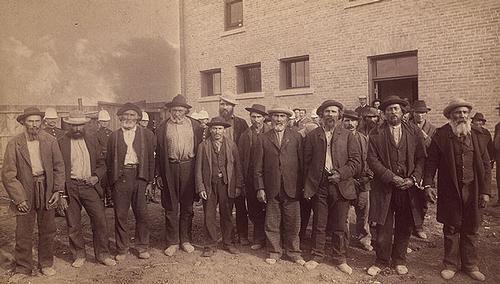
The indigenous peoples of Canada also include the Métis, approximately 200,000 people of mixed Indian-French descent.
The Métis people emerged when French-Canadian coureurs des bois (almost exclusively men) settled on the prairies with Native American women.
They lived as free people, had no king, commander or chief. They lived on products from the forests and sold or exchanged them for clothes, guns and salt, among other things.
Because of this way of life, the Métis were more of a "native nation" than a typical European community, although they spoke a Creole-French language (mistchiff = métis) and remained Catholic.
A quote from the famous Métis, Louis Riel, says enough about how the Métis feel like an authentic Canadian people:
"What matter is it what part of our blood is European or indian? We are the Métis. Our people was born in the pariries".
Almost the entire current population of Canada is made up of immigrants and their descendants. Over 25% are of British and Irish descent, approximately 24% are French, 4% German, 3% Italian, 2% Ukrainian, 1.4% Dutch. About a quarter of a million Canadians are originally Dutch and live mainly in the provinces of Ontario and Québec. Vancouver has the second largest Chinese community outside the Far East, just after San Francisco, with 100,000 souls. The government's immigration policy aims to admit only as many immigrants as is compatible with the land economy.
After 1945, Canada admitted approximately 4.6 million immigrants, with peak years of 1957 (approximately 280,000) and 1992 (approximately 252,000). The number of immigrants from Europe has been declining since the 1970s, and most of them are currently from Asia. Most immigrants settle in the provinces of Ontario, Québec, British Columbia and Alberta.
The number of non-Canadian-born residents fluctuates around 15%. Most immigrants settle in Toronto, Montreal and Vancouver.
The population of Canada in 2024 was approximately 38.8 million. The population density is just over 4 inhabitants per km2. Two-thirds of the enormous country is virtually uninhabited. The annual population growth rate was 0.71% in 2024. Life expectancy at birth is 86.6 years for women and 81.9 for men. (2024) The population distribution is very uneven. The vast majority of the country, especially the north, is very sparsely populated. The average number of inhabitants per km2 is approximately 4 inhabitants, but Nunavut, for example, has a population density of 0.013 inhabitants per km2. The number of births per 1000 inhabitants is 10 and the number of deaths is 8.2 per 1000 inhabitants. (2024)
The population structure is as follows:
• 0-14 years 15.5%
• 15-64 years 63.4%
• 65+ 21%
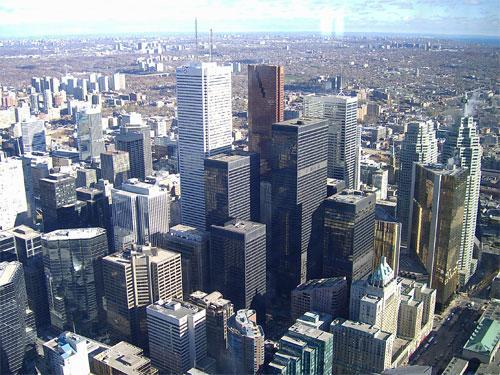
Most of the population is concentrated in a relatively small strip along the southern border. More than 80% of Canadians live no more than 200 kilometers from the border with the United States. The center of gravity lies in the area of the St. Lawrence and the Great Lakes: here are seven of the fifteen major agglomerations in Canada. The urban population comprises 81% of the total population. The main focus is in the provinces of Ontario and Québec, with successively 36% and 26% of the total population.
Ten largest agglomerations (2016):
Toronto, Ontario 5,900,000
Montreal (Québec) 4,100,000
Vancouver (British Columbia) 2,465,000
Ottawa / Hull (Ontario) 1,325,000
Calgary (Alberta) 1,390,000
Edmonton (Alberta) 1,320,000
Québec / City (Québec) 800,000
Winnipeg (Manitoba) 780,000
Hamilton (Ontario) 750,000
London (Ontario) 490,000
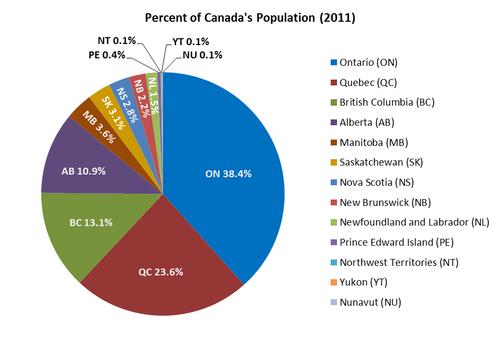
A special group are the approximately 600,000 Acadians. Acadia was the eastern part of former French Canada, colonized from 1604 and partially assigned to the Treaty of Utrecht in 1713. The territory corresponded to the current coastal provinces of Nova Scotia and New Brunswick, and was the subject of ongoing conflicts between England and France, which Nova Scotia lost to the Peace of Utrecht.
In 1755, some 18,000 Frenchmen refused to show allegiance to England, after which they were deported to other British colonies, especially Louisiana in the United States.
At the Peace of Paris in 1763, Acadia finally fell into English hands. Today, there are approximately 1 million Acadians living in Louisiana, 300,000 in the territory of the former Acadia, and the same number in the rest of Canada.
Language
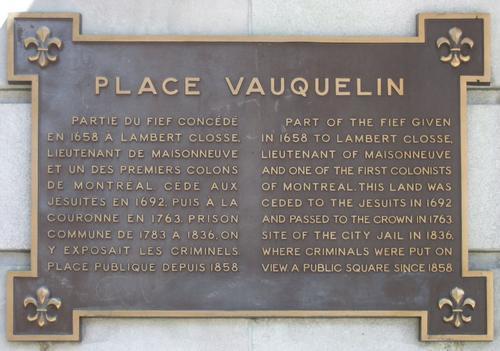
Canada has two official languages, English and French. French is the mother tongue of 24% of the population, English of 63% of the population.
Canadians have their own distinctive accent, but written Canadian English is very similar to English in Britain. Outside of Quebec, fewer and fewer people are native French speakers, and while French-speaking communities still exist in the maritime provinces of Manitoba and Ontario, in some areas the language has been heavily influenced by English in terms of words and sentence structure. This has led to an incomprehensible mixing language for an outsider, which is called "franglais".
At the urging of the French speakers from Québec, the Canadian federal government decided in 1969 to officially make all of Canada bilingual.
French is the official language in Québec, but English is predominant in the rest of Canada. The Ottawa government center is bilingual, as all officials must have a command of both French and English.
French has changed considerably over time. Especially in the big cities, the "Canadiens" use more and more anglicisms. Some words that are already obsolete in France are still used here, such as "charette" for dump truck and "fin-de-semaine" instead of "le weekend". Furthermore, there is a huge variation in the type of French spoken. Over time, a dialect called "Joual" has emerged in Québec.
Some expressions from Joual:
- Avoir lair anglais = looking strange
- Very much = am gross
- Dollar = piastre
- Cents = bidous
Eight indigenous languages are spoken in the Yukon Territory of northwestern Canada. Seven of them are from the Athapasque language family: Gwich'in, Han, Kaska, Northern Tutchone, Southern Tutchone, Tagish and Upper Tanana. Furthermore, Tlingit is spoken, which is somewhat related to Athapasque.
The inhabitants of Newfoundland have their own dialect with a somewhat Irish accent, but with unique words and expressions:
A very difficult assignment = to have a noggin to scrape
Without worries = in a hobble
He bothers me = he is moidering my brains
Good luck = long may your big good jib draw
The Inuktitut, the language of the Inuit, is a living language and is still growing. It is a widespread language in northern Canada, and Inuit across the Arctic can understand each other. Dialects and accents vary from region to region, but Inuktitut is a standalone language.
One of the first things to notice is that a word with the same meaning is spelled in different ways. When a writing system was developed about 100 years ago, the words were written phonetically, and those phonetic versions differed per region.
Since the seventies of the last century, attempts have been made to develop a standard Inuktitut, but that is still very difficult.
The English whalers brought along several words that are clearly recognizable as such:
- Tea - tii
- Sugar - sukaq
- Waistcoat - uasikuaq
- Paper - paipaaq
Other words and phrases from Inuktitut:
- Father - ataata
- Mother - anaana
- Son - irniq
- Daughter - panic
- Winter - ukiuq
- Summer - auja
- The wind blows - anuraaqtuq
- Mist - taktuk
- Wind - anuri
- How are you? - Qanuipit?
- Thank you - Qujannamiik
- Help! - ikajunga!
- Yes - ii
- No - aaka or aagaa
The name Canada is derived from the Iroquis Indian word "kanata", which literally means "place of business".
More than 50 different Indian languages and dialects are spoken in Canada, each belonging to one of the ten basic language groups. The largest of these is the Algonquin, followed by the Athabasca, Iroquoi, Salish, Wakasha, Tsminschian, Sioux, Kootenai, Haida and Tlingit.
Many place names are of Native American origin:
- Kelowna (British Columbia) = grizzly bear
- Kamloops (British Columbia) = intersection of waterways
- Ucluelet (British Columbia) = people with a safe haven
- Saskatchewan = river with spinning current
- Manitoba = great life force
- Winnipeg (Manitoba) = cloudy, dark water
- Quebec = when the river widens
- Lake Cowichan (British Columbia) = heated by the sun
- Takakaw (British Columbia) = it is beautiful
- ukon = large water
- Kluane (Yukon Territory) = place with a lot of fish
- Ontario = beautiful water
- Penetanguishene (Ontario) = place of the undulating white sand
- Ottawa (Ontario) = place to buy and sell
- Toronto (Ontario) = meeting point
- Gaspé (Québec) = where the country ends
Religion
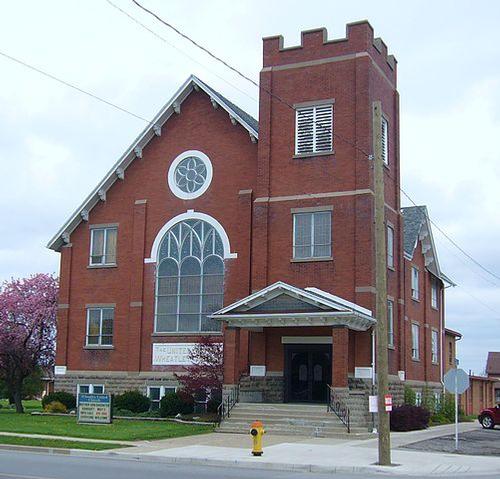 Wheatley United Church of CanadaPhoto: Ducio1234 in the public domain
Wheatley United Church of CanadaPhoto: Ducio1234 in the public domain
In the 16th century, due to the immigration of the French, the population of Canada was mainly Roman Catholic. In 1759 Canada came into British hands, after which Protestant churches from Great Britain were given the opportunity to expand here, and Canada gradually became more Protestant.
Canada is home to almost all denominations and philosophical groups. At present, approximately 45% of the population is Roman Catholic, mainly French speakers, 18% belong to the United Church of Canada, 12% belong to the Anglican Church of Canada, 3% are Presbyterian, 3% Lutheran and 2 .5% Baptist. Also to be mentioned are the Reformed Church, to which many Dutch Reformed immigrants joined, and the Christian Reformed Church, to which many Reformed members have joined.
The Catholics of the Byzantine rite - mainly (descendants of) immigrant Ukrainians (Ruthenians) - have their own hierarchy and monasteries in Canada. Canada has over 340,000 Jewish residents and many Muslims, Buddhists and Hindus.
Canada also owns an Amish community in Ontario. The Amish or Ammanites are a spin-off from the Christian Mennonite community founded in Europe in the early 16th century. They were prosecuted for refusing to take the oath or carry weapons. In the 17th century an even stricter sect split off, emigrating to America and in 1799 to Ontario.
| Religion | 1981 | 1991 |
| Non-believers | 7,4% | 13,0% |
| Buddhists | 0,2% | 0,6% |
| Catholics | 47,3% | 45,7% |
| Protestants | 41,2% | 36,2% |
| Eastern Orthodox | 1,5% | 1,4% |
| Hindu | 0,3% | 0,6% |
| Muslims | 0,4% | 0,9% |
| Jews | 1,2% | 1,2% |
| Sikhs | 0,3% | 0,5% |
| Others | 0,2% | 0,2% |
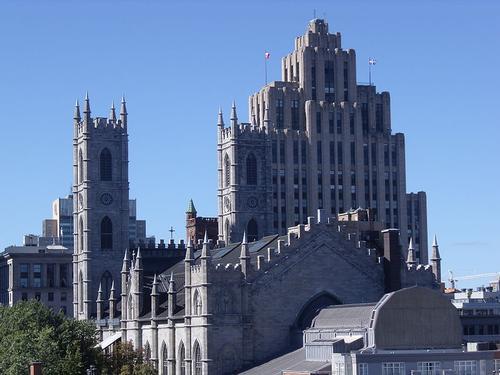
One of the most beautiful churches in North America is the Catholic Basilique Notre-Dame in Montreal. The original building is from the 17th century, but construction of a new church started in 1829. The church offers 3800 places in the nave and on the balconies.
Montreal's largest church is the Oratoire Saint-Joseph. The octagonal copper dome is one of the largest in the world - 44.5 meters high and 38 meters in diameter. The city of Montreal also has more than 300 churches and metropolitan Montreal even 450. Of these, 70% are Roman Catholic, 20% Protestant, 4% synagogues and 6% are churches of other denominations.
The Church of Inuvik, in the far north of Canada, was built in the shape of an igloo because of the climate.
The Cathédrale de Gaspé on the Gaspé Peninsula is North America's only wooden cathedral. Church Point, Nova Scotia, is dominated by the early 20th century Saint Mary's Church, the tallest and largest wooden church in North America.
The Basilique Notre-Dame-de-Québec is more than 350 years old and the oldest parish in North America.
The Cathédrale Anglicane in Québec-City is the first Anglican cathedral to be dedicated outside Britain (1804).
Winnipeg has the largest Ukrainian group outside Ukraine in its territory. The many Russian Orthodox churches with their onion-shaped domes and spiers testify to this, such as the Holy Trinity Ukrainian Orthodox Cathedral, the St. Vladimir and Olga Ukrainian Catholic Church and the St. Nichols Ukrainian Catholic Church. These churches are also part of the landscape in the prairies. The first Ukrainian churches were built from the beginning of the massive Ukrainian influx that started in the late 19th century, affecting both Roman Catholics and Russian Orthodox.
Near Cardston, in the Waterton Lakes National Park, is Canada's only Mormon temple, a snow-white structure built in 1913.
Sources
Elmar Landeninformatie
Wikipedia
CIA - World Factbook
BBC - Country Profiles
Copyright: Team The World of Info